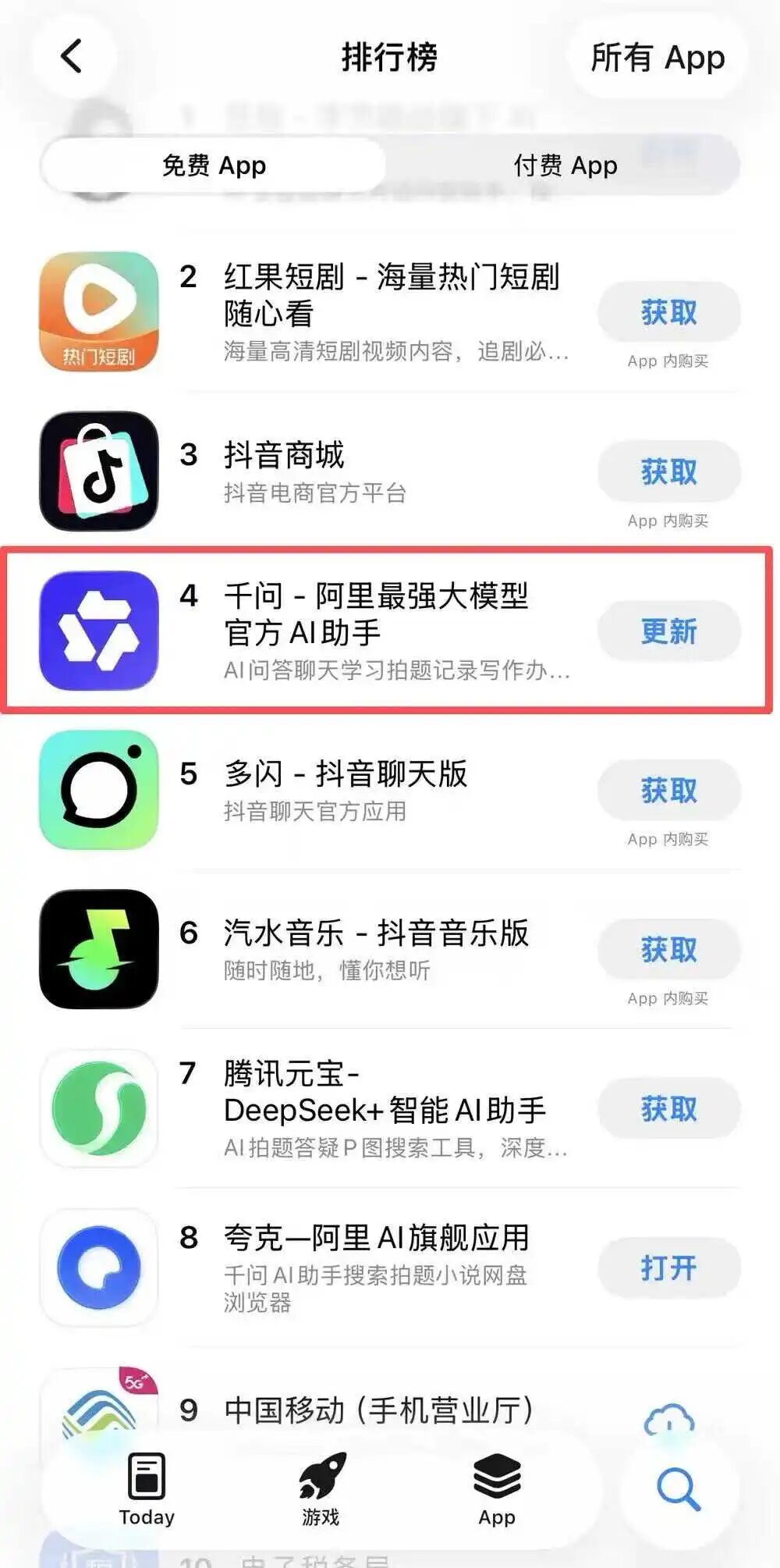Qianwen APP: Unveiling Alibaba's Grand Ecological Vision
![]() 11/19 2025
11/19 2025
![]() 478
478

Author: Wu Di
Editor: He Kun
Operations Manager: Chen Jiahui
Produced by: Lingtai LT (ID: LingTai_LT)
Header Image: Sourced from Public Domain
On November 17, 2025, the public beta release of Alibaba's Qianwen APP sent shockwaves through the industry, far exceeding initial expectations.
Within just 24 hours of its launch, the servers experienced multiple crashes, igniting fervent discussions within overseas developer communities. Airbnb's CEO lauded the app publicly, while Zheng Weimin, an academician at the Chinese Academy of Engineering, praised its "comprehensive, detailed, and logically sound answers."

Behind this frenzy lies a significance that transcends mere AI product innovation. Amidst the homogenization and fierce competition of large models, Qianwen's debut represents a strategic reinforcement for domestic AI, attempting to disrupt the current competitive landscape of the AI industry through a multifaceted approach encompassing "open source, ecosystem building, and consumer-end engagement."

The Ultimate Clash: Open Source vs. Closed Source
As global AI giants grapple with outages, Chinese AI has made a significant stride in its quest for breakthroughs.
On November 18, 2025, a historic outage at Cloudflare, a U.S. cybersecurity provider, swept across the globe, crippling dozens of platforms, including ChatGPT, and disrupting work for millions of users. The six-hour disruption caused Cloudflare's stock price to plummet nearly 3%.
On the other side of the world, Alibaba's Qianwen APP faced a similar challenge during its public beta. However, it swiftly restored stability through emergency scaling by Alibaba Cloud, now handling diverted global traffic seamlessly without any downtime.

This stark contrast fundamentally underscores a true competition in technical architectures and computational reserves.
The core strength of Qianwen APP lies in the Qwen3 large model. Dubbed Alibaba's "world's strongest open-source model," this flagship product has achieved two critical breakthroughs in technical architecture, forming the bedrock for its differentiated competition.
The first breakthrough is the implementation of a hybrid reasoning mode. It allows users to seamlessly switch between thinking and non-thinking modes, balancing complex reasoning with efficient responses. Currently, fewer than three products globally support this mode-switching capability.
The second breakthrough is full-series open-sourcing. From edge models with 0.6 billion parameters to flagship models with 235 billion parameters, all adopt permissive Apache 2.0 licenses, enabling free modification and commercial use. Cumulative downloads have surpassed 600 million.
The open-source strategy aims to cultivate a complete ecosystem. By exposing model weights, it attracts global developers for optimization, creating a virtuous cycle of "community feedback → model iteration → product upgrades."

As Jensen Huang, CEO of NVIDIA, noted, Qwen has become integral to Silicon Valley's AI infrastructure. This accumulation of a developer ecosystem represents long-term competitiveness that closed-source models struggle to replicate.
Proponents argue that Qwen3 achieves breakthroughs where small models deliver large capabilities. The 4 billion-parameter model matches the performance of its 72 billion-parameter predecessor and can be deployed on consumer-grade GPUs, significantly lowering the barriers to AI adoption.
However, critics point out persistent shortcomings in hardcore programming and complex multi-task scenarios. For instance, its GameBoy emulator only runs simplified Tetris versions, failing to support multiple games—a gap from its "world-class" claims.
This controversy highlights trends in the AI industry. The "parameter race" is becoming obsolete; "practical implementation" now defines core competitiveness.
Closed-source models maintain short-term technical leads, while open-source better aligns with the demands of AI industrialization.
As the capability gaps between models narrow, those who adapt faster to real-world scenarios, lower usage thresholds, and connect more developers will seize the long-term initiative.

Alibaba's Grand Ecological Ambitions
According to comprehensive media data from Tianyancha, Qianwen APP has initially integrated services like Gaode Maps, Taobao, and DingTalk. Future plans include AI Agent capabilities for automatic ticket booking, dining orders, ride-hailing, and shopping price comparisons—attempting to replicate WeChat's "connect everything" logic and create an AI-era super-portal.
Alibaba never positioned Qianwen APP as merely a chatbot. CEO Wu Yongming explicitly stated the goal: to create "an AI life assistant that gets things done." The backbone of this "getting things done" capability is Alibaba's vast ecosystem, which undoubtedly represents Qianwen's greatest potential for growth.
Unlike ChatGPT's standalone tool nature, Qianwen APP's AI+X model resembles a well-equipped army corps. Taobao's e-commerce data, DingTalk's office scenarios, and Gaode's geolocation information provide AI with more precise demand insights.
For example, when users inquire about "winter infant skincare," Qianwen can directly link to Taobao for compliant product recommendations and Gaode for nearby maternal stores—a scenario-based closed loop that ChatGPT struggles to match.
Yet, undeniably, this ecological closed loop serves as both Qianwen's strongest asset and Alibaba's greatest constraint.

Historical experience shows that Alibaba's cross-departmental product synergy remains inefficient. Previous interdepartmental projects stalled due to resource coordination issues, leaving uncertainty about whether Qianwen APP can break this curse. Therefore, Qianwen APP must also guard against ecological "closed-loop traps." It should avoid confining itself to Alibaba's ecosystem and instead pursue third-party scenario integrations, particularly ensuring core functions transcend basic Q&A and content generation.
Ecological synergy also poses Qianwen's most daunting challenge. Alibaba's ecosystem is overly complex, with multiple AI products like Kuake's AI search, DingTalk's office AI, and Taobao's smart customer service creating functional overlaps.
Alibaba's ecological resources differentiate Qianwen APP from products like ChatGPT, but balancing internal synergy with external openness, short-term functionality with long-term ecosystem building, will determine whether Qianwen evolves from a "product" into a true "universal AI portal."

The Future Lies in Open Ecological Synergy
Qianwen APP emerges against two backdrops.
First, at the self-level: Alibaba's scenario integration remains in its infancy, with a conversion gap between core functions and user experience. While its open-source strategy rapidly expands the ecosystem, it faces the challenge of balancing ecological scale with commercialization. Internal data silos further constrain scenario fusion. During the public beta, unexpected traffic surges caused accessibility issues and delayed command responses, sparking user debates.
Second, domestic large model competition has entered a red ocean.
Against this backdrop, Qianwen APP leverages clear technical advantages and strategic ecological positioning to pursue differentiated breakthroughs. The core lies in transforming technical advantages into irreplaceable user value.

Technologically, it implements tiered adaptation: 4 billion-parameter models for mobile, 32 billion-parameter models for enterprises, precisely matching capabilities to needs.
Ecologically, it opens training toolchains to drive industry-specific model development, shifting from "single models" to "solution ecosystems."
Scenario-wise, it gradually breaks internal data silos, deepening integration with shopping, office, and other high-frequency scenarios—upgrading from "conversational" to "task-oriented" capabilities. Meanwhile, computational scaling and load optimization address initial experience gaps.
With Qwen3's strong performance in math and coding tests, its open-source ecosystem has formed network effects, continuously boosting developer participation. Coupled with Alibaba's over 1 billion monthly active user base providing natural adoption grounds, the "technology-ecosystem-scenario" virtuous cycle becomes clear.
Undoubtedly, Qianwen APP's public beta marks a significant milestone for domestic large models.
It breaks technical barriers through open sourcing, finds differentiation via ecosystems, and proves domestic AI's strength through service stability. Yet Qianwen's challenges have just begun: technically, it must address complex scenario shortcomings; ecologically, it needs to resolve synergy issues; commercially, it must balance free access with profitability.
For the industry, Qianwen's emergence holds profound significance. It demonstrates to enterprises that abandoning "parameter anxiety," focusing on "user value," strengthening "computational foundations," reducing "technical imitation," and pursuing "model innovation" offers a more viable path.
This undoubtedly opens a new gateway for domestic AI: AI's future resides not in laboratory benchmarks, but in users' daily scenarios; not in closed technical barriers, but in open ecological synergy; not in fragile third-party dependencies, but in autonomous, controllable infrastructure.
End








